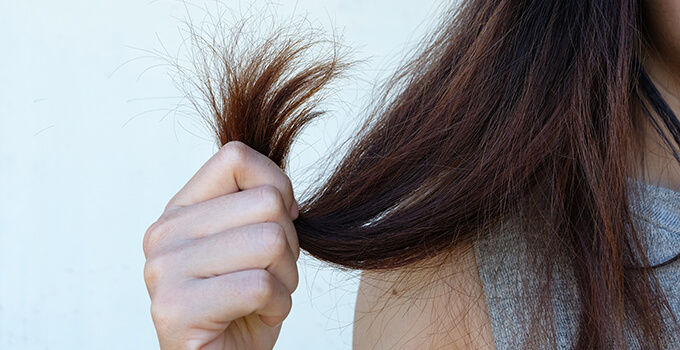
What are split ends?
Almost everyone suffers from it from time to time: split ends. But how do you get them? In this blog, we will explain and give you tips to prevent split ends as much as possible.
What are split ends?
A hair consists of several hair layers. If you have damaged hair, the outer layer of your hair is damaged. This causes the inner hair layer to lose protection, which dries it out. The result: split ends. You can recognise split ends by the small white dots at the bottom of a hair or when a hair has several hair ends, instead of one. This can be two, but sometimes even three, four or more!
How do you get split ends?
Your hair is made up of hair cuticles that are naturally smooth over each other. This results in shiny locks: light reflects better on a smooth surface. If the cuticles are damaged, they no longer fit together properly; this also makes it easier for moisture to escape from your hair. Your hair loses its shine, becomes dry, feels stiff and your ends split.
Hair damage can have several causes. The most common causes are friction, heat and the use of chemicals.
Split ends due to friction
Friction, for example when drying your hair with a towel or while sleeping, brushing your hair or putting in an elastic band, can pull up the hair cuticles, so to speak. One piece of hair will rub over another, resulting in a split tip.
Split ends caused by heat
We almost all use it: the hair dryer, straightener and curling iron. Unfortunately, heat is a major cause of split ends. This is because it affects the moisture content in your hair: the surface dries out. Especially with frequent use, your hair becomes drier and drier and cracks appear. The result: split ends. Besides styling tools, (excessive) exposure to the sun's heat also affects the health of your hair. This is because the sun's bright UV rays can dry out hair considerably.
Split ends caused by chemicals
Aggressive hair dyes, bleaching your hair or perming can damage your hair significantly. Many hair dyes contain ammonia, an alkaline substance that causes your hair cuticles to open so that the dye can penetrate the hair more easily and deeply. The result is beautiful at first, but in the long run your hair will suffer. Your hair cuticles get damaged so they no longer connect properly. This will leave you with dry, brittle hair and split ends.
Bleach removes the colour pigments from your hair. The active ingredient in bleaching products is hydrogen peroxide. You have hydrogen peroxide in different percentages from 3 to 30%. The higher the percentage, the greater the effect, but also the worse for your hair. Bleach also opens your hair cuticles. If you regularly blonde your hair, there is a risk that the hair cuticles will remain permanently open. Do you bleach or highlight your hair yourself? Then always use a professional product that puts as little stress on your hair as possible, such as the WECOLOUR bleach and highlight set.
A perm changes the structure of your hair, giving it a permanent wave or curl. You will keep this effect for about six months. A perm uses the alkaline liquid ammonium thioglycolate. This opens the hair cuticles and causes existing sulphur compounds in your hair to be broken. These sulphur compounds will never fully recover and the hair cuticles are also damaged; your hair becomes more vulnerable and is therefore more likely to break and split more easily.
What can you do about split ends?
Unfortunately, you cannot repair split ends. The only way to get rid of them is to cut off the split ends. If you do not do this, your hair will increasingly split upwards. More and more will have to be cut off! If you want to keep your locks as long as possible, visit your hairdresser regularly.
How can you prevent split ends?
You will never get rid of split ends completely. But you can prevent them as much as possible by taking proper care of your hair.
Get a regular haircut
Have your hair cut every six to twelve weeks, depending on your hair type. This will allow the hair at the root to continue growing and you will keep the length without further splitting. Leaving too much time between cuts will result in dead ends.
Make your hair strong from the inside out
When your hair is strong and healthy, it is less fragile and less likely to split. Of course, eating a healthy and varied diet will get you a long way. But there are some products you can put on your shopping list to get your hair in optimal condition from the inside out, such as salmon, green vegetables and dairy products. You can read more about these in our blog vitamins for your hair. Of course, there are also a lot of supplements on the market to give your hair the extra vitamins it needs.
Wash your hair as little as possible
Washing your hair too often can also make it more likely to develop split ends. This is because shampoos not only remove dirt, but also the natural oils that keep your hair and scalp healthy and supple. If you wash it too often, it can lead to hair damage and dehydration. Shampoos containing sulphates are especially harsh.
Use a conditioner after washing
Make sure you always use a conditioner after washing your hair. Shampoo opens your cuticles during washing to deeply cleanse the hair and absorb ingredients. A conditioner gives your hair extra care and then closes the cuticles again. It also wraps a soft protective layer around your cuticles. It therefore protects your hair from external factors such as heat tools, brushes, sun and wind. If you don't use conditioner, your hair cuticles will remain open from washing. Leaving your hair dry and more likely to split.
Dry your hair gently
Once you have turned off the shower, gently squeeze the water out of your hair before drying it further with a towel. Use a towel made of very soft material or a cotton t-shirt. Make sure you dab your hair gently and don't rub it when you dry your hair. If you rub your hair too wildly with a towel, chances are that your hair cuticles will tear. This is because wet hair is very fragile and can break and split easily.
Do not sleep with wet hair
Because wet hair is very fragile, it is wise not to go to sleep with wet hair. The friction with your pillow can damage your hair faster than going to bed with dry hair. Therefore, make sure your hair is thoroughly dry. Do you have long hair? Then wear your hair in a loose, low ponytail or braid while sleeping. This will reduce friction and tension on your hair.
Change your cotton pillowcase for one made of silk
Most pillowcases are made of cotton or a mix of cotton and polyester. These pillowcases have a rougher surface, causing more friction with your hair (and skin) while sleeping. This causes you to get tangles faster and your hair to break and split. In addition, cotton absorbs moisture from your hair. Sleeping on a silk pillowcase reduces friction due to its smooth texture and keeps the moisture where it belongs: in your hair.
Use heat protection spray before styling
Make sure you use a heat-protective product before you start working with heat on your hair, such as with a hairdryer, straightener or curling iron. This will protect your hair and prevent unnecessary split ends. Try to set the temperature as low as possible and make sure your hair is thoroughly dry (or while blow-drying, as dry as possible). When styling or curling your hair, do not use hair products such as hairspray or shine serum, but apply these after styling.
Moisturise your ends
Keep your dry hair ends hydrated and nourished. For example, use a conditioning hair mask or deep conditioner once a week to give your hair the extra care it needs. A serum or hair oil can also moisturise and add shine to your hair lengths. It ensures that your hair retains moisture, making it less dry.
Limit the use of rubber bands
Many women use them: rubber bands to secure hair in a cute ponytail, bun or braid. But unfortunately, these rubber bands cause friction in your hair. Therefore, do not tie your rubber band too tightly around your hair and use rubber bands without metal pieces in the middle. Your hair can get caught in them and break off. A scrunchie is a good alternative and looks nice too. Or use soft thick cotton rubber bands.
Avoid chemical treatments
Leave your hair untreated as much as possible. As we mentioned earlier, chemical treatments like regular dyeing, bleaching or perming can damage your hair considerably. Yet we at WECOLOUR understand all too well that you want to give your hair a nice, well-cared-for hair colour, especially when you are already starting to go grey. WECOLOUR hair dye is as pure as possible, without ammonia, resorcinol and PPD. Much better and softer for your hair and you''ll notice that right away! Our bleach product is also much gentler on your hair than other products you buy in shops. For extra protection of your hair and scalp, you can add Colour Mask during dyeing and bleaching.
No split ends, but shiny locks
After reading this blog, you will know how split ends occur and what you can do to prevent your hair from splitting as much as possible. Try WECOLOUR hair care products, which are as gentle as possible and give your hair the extra care and hydration it needs to prevent split ends!
